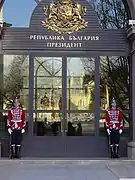National Guards Unit of Bulgaria
The National Guards Unit of Bulgaria (Bulgarian: Национална гвардейска част на България) is a unique Bulgarian military formation of regimental size, directly subordinated to the Minister of Defence. The unit is purely ceremonial, as the security of the President of Bulgaria, members of the government, of the Parliament and foreign dignitaries on official visits is provided by the National Close Protection Service (Bulgarian: Национална служба за охрана (НСО)). While it is considered by law to be a part of the Armed Forces of the Republic of Bulgaria, it is outside of the jurisdiction of the Defence Staff. The National Guard performs the ritual "Ceremonial changing of the honor guard of the Presidency" for the first time on 5 November 2003 and every hour changes guard at the administrative building of the President of the Republic of Bulgaria. The Guard also ensures the security of civil, military and industrial sites in Sofia.[1] The scarlet hussar style uniform of the Guards was established in 1883 and includes elements of national symbolism. Throughout political changes, uniform details such as the eagle feather on the cap and the Alexander star have been retained. The Alexander star was originally a feature of the Bulgarian royal order "St. Alexander".[2]
| National Guards Unit (Natsionalna gvardeyska chast) | |
|---|---|
 Bastille Day Military Parade 2007 in Paris | |
| Active | 1879–present |
| Country | |
| Branch | |
| Type | Honor Guard |
| Size | 315 |
| Garrison/HQ | Sofia |
| Patron | Saint George |
| Commanders | |
| Current commander | Brigadier general Ilko Yordanov |
| Insignia | |
| Alexander star |  |
History
The National Guards Unit of Bulgaria is the successor of the Personal Cavalry Convoy (squadron) of knyaz Alexander I, founded in 1879, when on July 12 the guards escorted the Bulgarian knyaz for the first time. Accordingly, 12 July is the official holiday of the modern National Guard Unit. Throughout the years the structure of the guards has changed from convoy to squadron, regiment and after 1942 - division. Today it includes military units for state and military ceremonies and a full military band. The guardsmen have however changed their weapons from cavalry sabres to infantry rifles. The standard issue rifle of the unit is SKS (Samozariadnaia karabina Simonova) and a ceremonial version of the AK-47 assault rifle. They also use the much heavier rifle Mosin–Nagant for training.
In 2001 the National Guards Unit was declared the official military unit representing the Armed Forces of Bulgaria and one of the symbols of modern state authority along with the flag, the coat of arms and the national anthem.
The mission of the National Guards Unit is not just to display military traditions and rituals but also to provide a center for their revival and enrichment in order to preserve and enhance the national identity of the Republic of Bulgaria and of its Armed Forces.
The National Guards Unit has its own regimental colour, seal, distinctive insignia and full dress uniform. The scarlet Guards' uniform was created in 1883 and includes elements of Bulgarian national traditions and symbols. It has remained essentially unchanged throughout the political changes of the last 130 years. The current insignia was introduced in 2002 and consists of Alexander star, which is part of the royal medal "St. Alexander" and is worn on the Guard's hat since 1883. It is placed over a shield in colours of the Flag of Bulgaria. The current regimental colour, which follows the pattern of the traditional Bulgarian military colours during the royal period, dates from July 12, 2003.
In 2003, on the eve of 6 May or St George's Day - the biggest Bulgarian military holiday, the Bulgarians saw for the first time the solemn show-ceremony "Iskra" ("Sparkle"). This performance is combination of spectacular demonstration of non-standard combatant positions, movement with and without weapon and saluting battle flags and the heroes, who gave their lives for the freedom and independence of Bulgaria. The ritual "Solemn changing of the sentry of honour in front of the Presidency" first took place on November 5, 2003.[3] The guards also formerly performed guard duties at the now destroyed Georgi Dimitrov Mausoleum.
Organization
Regimental Headquarters
- 1st Guard Battalion
- 2nd Guards mixed battalion
- Representative Brass Band
- Representative Ensemble
- Training Center
Gallery
 G. Obretenov with typical 19th century Bulgarian revolutionary uniform, prototype of the National Guards' uniform, c. 1876
G. Obretenov with typical 19th century Bulgarian revolutionary uniform, prototype of the National Guards' uniform, c. 1876.jpg.webp)
 Bulgarian Life Guards Cavalry Squadron, c. 1896
Bulgarian Life Guards Cavalry Squadron, c. 1896 Officers of Bulgarian Life Guards Squadron, 1903
Officers of Bulgarian Life Guards Squadron, 1903 Officer of Bulgarian Life Guards Cavalry Squadron, c. 1908
Officer of Bulgarian Life Guards Cavalry Squadron, c. 1908 Officer's Uniform
Officer's Uniform Serviceman's Uniform
Serviceman's Uniform.jpg.webp)
 Summer uniforms
Summer uniforms Winter uniforms
Winter uniforms Winter greatcoats
Winter greatcoats Changing of the Guard
Changing of the Guard Changing of the Guard
Changing of the Guard Parade during a visit of the President of Brazil Dilma Rousseff
Parade during a visit of the President of Brazil Dilma Rousseff
See also
- Coat of arms of Bulgaria
- Flag of Bulgaria
- Mila Rodino
- List of army units called Guards for other guard units.
References
External links
| Wikimedia Commons has media related to National Guards Unit of Bulgaria. |
- National Guards Unit official page (in Bulgarian)
- Official site of National Guards Unit.
- Rules of the National Guards Unit, passed on May 22, 2001. (in Bulgarian)
- "Дълг, чест и гвардейска душа", article in "Български войн" magazine, number 7, 2004. (in Bulgarian)
- "За честта и славата на родината" - в навечерието на Трети март", article in "Българска армия" newspaper, number 16310, March 3, 2006. (in Bulgarian)
- "Традицията се отстоява всеки ден", article in "Български войн" magazine, number 7-8, 2007. (in Bulgarian)